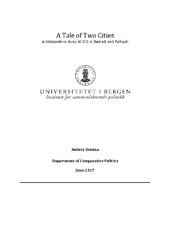A Tale of Two Cities. A comparative study of ISIS in Ramadi and Fallujah
Master thesis
Permanent lenke
https://hdl.handle.net/1956/16146Utgivelsesdato
2017-06-30Metadata
Vis full innførselSamlinger
Sammendrag
ISIS attacked Ramadi and Fallujah in the early days of January 2014, and while Fallujah fell at once with no visible resistance, it took protracted fighting and a three-day surge by ISIS before Ramadi fell on May 17 the same year. Through the application of social movement theory to the cases, I argue that it is possible to provide an understanding of the processes that led up to the two different outcomes, by looking at the Sunni Protest movement in Anbar throughout 2013. I argue that to understand the rise of ISIS, it is important to look beyond the group itself. It is necessary to include environmental dynamics, intramovement relations and the influence of outside actors in the analysis. This study finds that internal competition of frames caused Ramadi and Fallujah to develop differently. Fallujah was more receptive to extremist frames, while moderate frames resonated best in Ramadi. State repression and violence confirmed the dominant and extreme frames in Fallujah perfectly. The repression also affected Ramadi negatively, but not as much as in Fallujah. The radical flank effect increased the difference by affecting how the government handled the movement in general and how the government handled the cities specifically. As the Iraqi security forces pulled away from the cities after clashing with protesters in late December, the local councils inserted themselves as the governing bodies of Ramadi and Fallujah. Because Ramadi had remained relatively moderate, it was not in its interest to cooperate with ISIS, thus siding with the Iraqi security forces in fighting the extremists. Fallujah, on the other hand, which had been increasingly radicalised throughout the year, had no problem cooperating with ISIS. Fallujah let ISIS into the city, and that is why ISIS was able to enter unopposed in January 2014.
